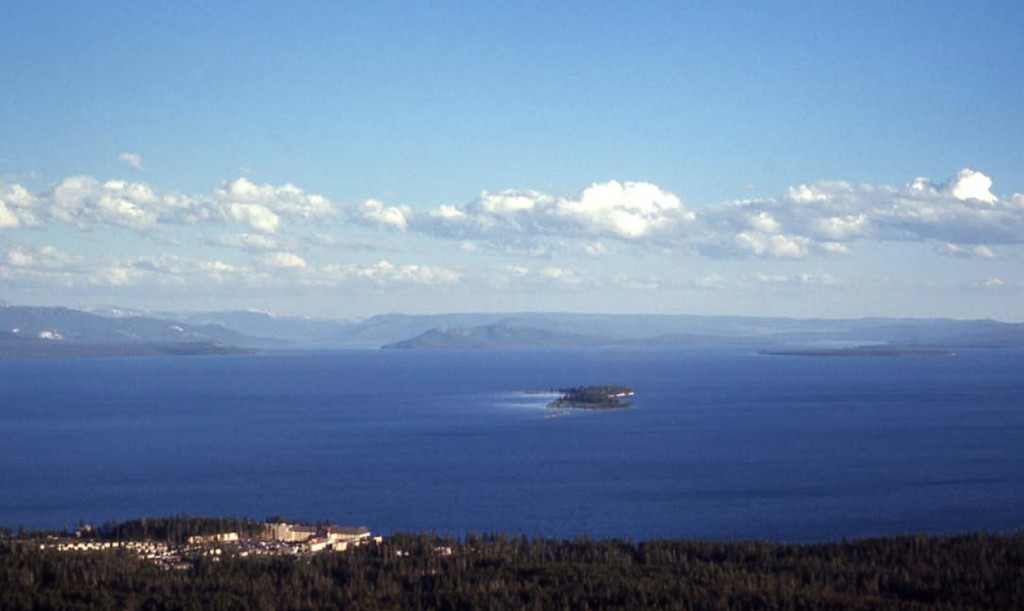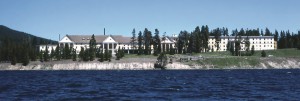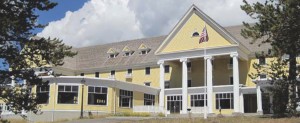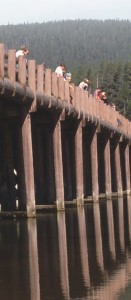
By Ruffin Prevost
CODY, Wyo. — Visitors are drawn to Yellowstone National Park’s Lake Hotel and the surrounding area for its expansive views, sweeping shoreline and historic structures. Spawning Yellowstone cutthroat trout use the streams emptying into Yellowstone Lake, and the fish attract grizzly bears.
Figuring out how to maintain and update developed facilities while preserving those natural attractions is the goal of a draft comprehensive long-range plan for Fishing Bridge, the Lake area and Bridge Bay released this month by the National Park Service.
Development, renovations and improvements around the Lake area will be guided by the long-term comprehensive plan and environmental review, a relatively new way of approaching planning within the park.
“This plan may be different than some in the past,” lead planner Alicia Murphy told a small gathering at a meeting in Cody earlier this month.

Comprehensive plans include design standards, zoning and other elements that haven’t always been a part of environmental reviews of developed areas in Yellowstone, she said. The Tower-Roosevelt area was the first in the park to undergo a comprehensive plan, while Old Faithful, Mammoth Hot Springs and Lake are in that process now.
The idea is to consider a wide range of factors and potential future possibilities and changes over a relatively broad developed area, said Eleanor Clark, chief of comprehensive planning for Yellowstone. As environmental factors or visitor use patterns change, the plan should give managers options for addressing those changes.
The 700-acre planning area hugs the northern shoreline of Yellowstone Lake and covers six distinct zones: Fishing Bridge, an administrative area at Lake, Lake Lodge, Lake Hotel, the lakeshore itself and Bridge Bay and its marina.
The iconic yellow Lake Hotel takes center stage in the minds of many frequent Lake area visitors.

Built in 1889 by the Northern Pacific Railroad as a plain, clapboard structure, Lake Hotel is the oldest surviving hotel in any national park. It was expanded and remodeled in 1903 by architect Robert Reamer, who also designed the Old Faithful Inn built that same year. Reamer added large porticoes supported by ionic columns, transforming Lake Hotel into a Colonial Revival landmark.
Comments from earlier scoping meetings have focused on preserving Lake Hotel and the vistas around the lake, Murphy said.
“The beauty of what you see is something we’re passionate about,” she said. “”People love the lake and they want to keep the serenity and tranquility of that area.”
Among the changes proposed in the National Park Service’s preferred alternative as outlined in the draft plan are:
- Seismic stabilization of Lake Hotel and installation of an emergency generator.
- Building a new entrance structure at the rear of Lake Hotel.
- Building a new concessions maintenance facility behind Lake Hotel.
- Closing a portion of the lakeshore road in front of Lake Hotel to vehicle traffic.
- Building new worker housing at Lake to replace aging “temporary” structures.
- Rehabilitating and reopening under adaptive use the Lake service station and fish hatchery buildings.
- Reopening the Lake Ranger Station to the public year-round.
- Dredging the mouth of Bridge Bay marina, which currently allows only a four-foot draft.
- Burying water lines leading to Fishing Bridge to allow for winter fire protection.
- Upgrading the Fishing Bridge RV park to allow for larger campers within the existing facility footprint.
- Building new shower facilities at Bridge Bay and Fishing Bridge campgrounds and a new shower and laundry facility at Bridge Bay Marina.
Murphy said some cabins would be moved away from Lodge Creek, where planners are hoping cutthroat trout will be spawning in increasing numbers as efforts continue to reduce predatory lake trout numbers.

She said other public comments during scoping meetings focused on preserving dark skies at night by avoiding unnecessary lighting and adding a bike path from Fishing Bridge to Bridge Bay.
A bike path through the woods might bring unwelcome encounters with bears, said John Osgood, a retired park ranger who worked in Yellowstone and Bighorn Canyon National Recreation Area.
Osgood said during the Cody planning meeting that relatively swift, quiet bicyclists could surprise bears that might use a bike path to move around at night.
Clark said any new bicycle path would probably follow the shoulder of the existing road between Fishing Bridge and Bridge Bay.
Larry Thomas of Cody said during the planning meeting that he opposed closing to vehicles a portion of the road along the shoreline near Lake Hotel.
Thomas said the he must “fight to find a parking space” whenever he visits the hotel, and closing the road will make it harder to navigate the parking areas.
The Greater Yellowstone Coalition on Wednesday announced its approval of the shoreline closure, but objected to other proposed changes, including upgrades to the Fishing Bridge campground, the only spot in the park with full RV hook-ups.
The conservation group sent an email urging members to oppose the “proposal to convert the existing Fishing Bridge RV campground into a massive expanse of asphalt intended to cater to enormous recreational vehicles.”

The GYC said the plan would reverse decades of grizzly conservation efforts at Fishing Bridge and result in a new paved area the size of a super Walmart. The group called on the Park Service to “to do more with less, rather than never-ending creep of more asphalt and concrete.”
Planning documents state that most of the new 8.7 acres of total net new pavement throughout the planning area would lie within the existing Fishing Bridge RV campground footprint, and that the campground area would not be enlarged. Murphy said during the Cody planning meeting that the size of a typical RV has increased greatly since the campground was first built, and that while some individual RV spaces would be enlarged, the total number of camping spots at Fishing Bridge would drop under the plan.
Planning documents do not include cost estimates or funding details. Such improvements and capital construction often occur as specific funding becomes available from a variety of public and private sources.
Contact Ruffin Prevost at 307-213-9818 or [email protected].

I couldn’t attend this meeting , but if I had gone I would’ve added two more issues :
1. Fishing Bridge itself is deteriorating. The fabulous log bridge , massive as it is, needs a new road surface. They’ve been fixing the fixes for a few years now. A big refurbishment of the bridge structure might also be in order. Re-routing the highway around it over a new bridge downstream may be in the long term plans, whether for a season , a couple years, or forever, Fishing Bridge will see the day when it can’t handle the traffic loads any longer without some real work. It’s a bottleneck..
2. Summer private recreational boat operators who berth in the slips at Bridge Bay marina are seeing their seasons shortened year after year. The concessionaire and/or Park Se4rvice are starting to close the marina facilities in mid-September and close the marina itself by October 1. The Lake didn’t open to the public till June 15 this past year, so the watercraft season is barely 3 months long. That is a full month shorter than it used to be, when Yellowstone Lake facilities were open till October 10-15 or so from an e arlier June opening date. The dock bills certainly haven’t gone down any…boats are assessed north of $ 900 per summer for a slip space, but are getting handed a shorter season. Not fair.